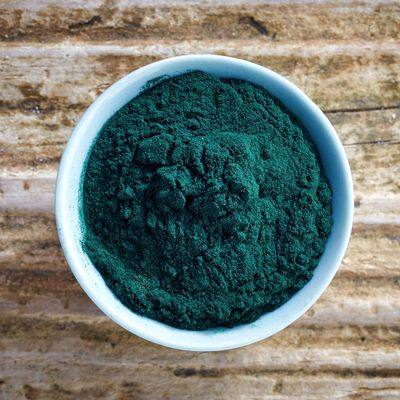
Whenever I go to the fancy smoothie place by my apartment — to treat myself to one packed with peanut butter and chocolate, of course — I always notice that spirulina seems included in many of the healthier options they offer. In fact, I’m even given the option of adding it to my arguably unhealthy smoothie, too. But I’m not quite sure what exactly spirulina is — I’d assume it’s some sort of spiral pasta from the name, though logically I know better than that. So to get the lowdown on spirulina, and to find out if I should be adding it to my smoothies, I consulted with two experts.
First off, what even is it? Spirulina, believe it or not, is a blue-green algae. Yes, algae. But unlike the algae growing in your parents’ pool, this type of algae is actually healthy to consume, according to registered dietitian Brigitte Zeitlin. “The truth is, what would make algae unsafe to eat would be the bodies of water it’s in, not so much the algae itself,” she explained. Most people consume their spirulina in powder form (which is why you often find it in smoothies), but you can also consume it as a tablet.
So, what does spirulina do? Well, as it turns out, the fancy smoothie place tries to get me to consume spirulina not just to add to the cost of my beverage. Instead, spirulina is actually considered to be a superfood, since it’s packed with minerals and antioxidants. As registered dietitian Amy Shapiro explained to me, spirulina has been shown to help with heart health, in that it can reduce your bad cholesterol and triglyceride levels, and also decrease blood pressure and prevent artery clogging. It’s also known to be antimicrobial, so it can help promote the healthy bacteria in the gut that prevents the overgrowth of bad bacteria, she added. Spirulina is also a good source of protein and vitamin B12, so it could be a good way for vegans to ensure they’re getting enough of those things in their diets.
Hmm, but I heard it can also help with allergies. Is that true? Apparently, yes! While the rest of us are stuffing Claritin down our throats all allergy-season long, other people seem to be merely adding spirulina to their diets. According to Zeitlin, that’s because spirulina has been effective in stopping the release of histamine in your body, so it can work almost like a natural antihistamine.
Okay, so how much should I take each day? If you’re new to spirulina, Shapiro recommends starting out slowly — with just a teaspoon per day. You see, spirulina isn’t like a drug — taking it one time isn’t any sort of cure-all. Instead, the health benefits are observed over time. So she recommends newbies ease their way into adding spirulina to their diets, and then eventually you could take a tablespoon or so each day.
How should I be ingesting it? Well, since spirulina generally comes in powder form, eating it on its own just sounds gross. But as Zeitlin notes, if you think of it as a condiment or topping, you can eat it by simply adding it to whatever you’re already planning on eating, from Greek yogurt to your smoothie to an acai bowl. Shapiro added that if you want to go a step further, you could simply mix it with some water and take it like a wheatgrass shot.
What should I look out for when buying it? Spirulina can be found at most health-food stores and markets nowadays, but Shapiro explained that when you actually go to buy some, make sure you’re buying spirulina that’s organic, well-sourced, and has no additives.
Who should stay away from spirulina? Shaprio cautions that pregnant women should stay away from the algae, since not much is known about its effects on a developing fetus. On top of that, she also noted that people who are on blood-thinners might want to consult their doctor before they consume any spirulina, since it’s known to be high in vitamin K.





